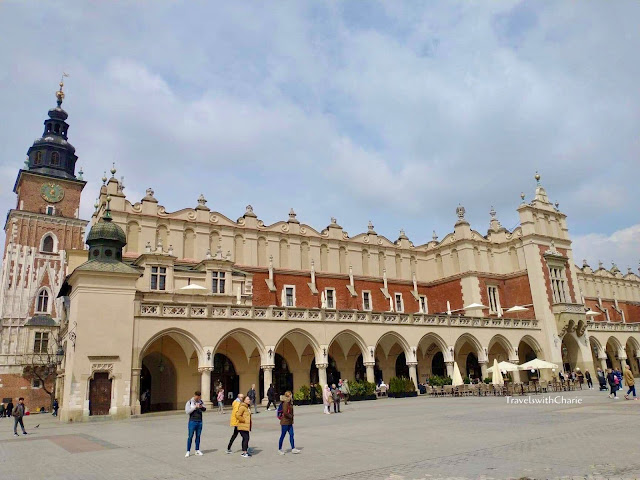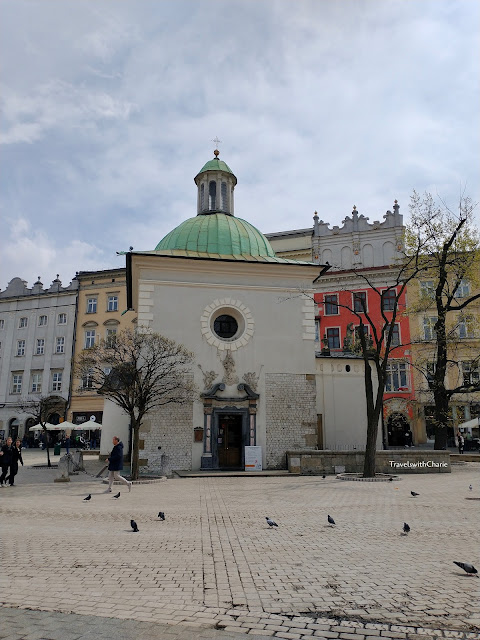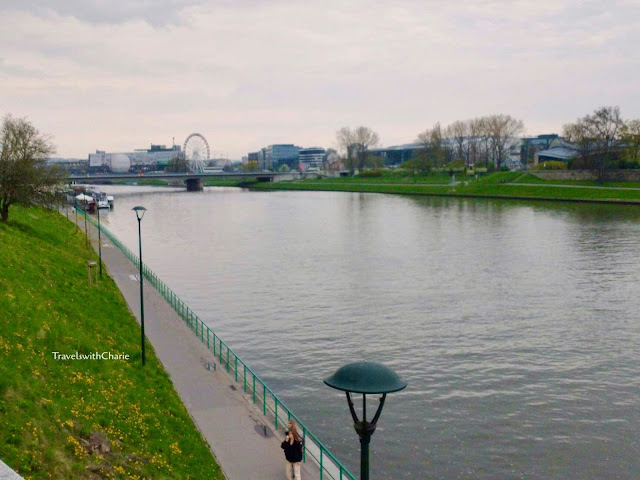St. Mary’s Basilica
The current Basilica was built in the 14th century on the foundation of an older church from the 13th century. It is part of the UNESCO World Heritage site which includes the entire Stare Miasto (Old Town) of Krakow. Jan Matejko, the foremost painter of Poland designed the polychrome murals of the Basilica and the wooden altarpiece behind the main altar was carved by Veit Stoss in the 15th century. It depicts the life of Jesus and Mary. The altarpiece was dismantled and hidden in various locations across Poland just before World War II broke out but was found by the Nazis and taken to Germany. It was recovered in 1946 and had to undergo major restoration before its reinstallation at the Basilica in 1957. There is a guided tour of the St. Mary’s and tickets can be purchased at their office which is on the side of the main portal overlooking Main Square.St. Mary’s Basilica
I wondered why the people were gathering in front of the Basilica. It turns out that a trumpeter plays the “hejnał” to signal the time to the crowd from the top of one of the unmatched towers. When he finishes playing to the crowd on the Main Square, he turns around and starts playing again until he has covered all cardinal directions - north, south, east and west. St. Mary’s Trumpet Call has been sounded since the 14th century and was originally played to tell the gatekeepers to open or shut the city gates and at times to warn the people of fire or the approach of enemies. Listen to the Trumpet Call here: http://www.krakow-info.com/signal2.wav*.
*from Wikimedia Commons.
Sukiennice (Cloth Hall)
Before the Cloth Hall was built, shopkeepers sold their wares on the square and had to contend with rain and cold, heat and snow. Then a covered market was built in the 15th century when Krakow was the capital of Poland and the center of international trade. When the capital was moved to Warsaw in the 16th century followed by the Swedish wars of the 17th century and the partition of Poland, Krakow entered a lengthy period of decline. The Hall was left to languish until 1870 when it was renovated in the Renaissance style.
Interior, The Cloth Hall
We were still under pandemic conditions in early May and tourists had not descended on Krakow. It was fun to check out the shops without jostling for space. I was looking for an amber bracelet (Krakow is known as the Amber City) and found a beautiful piece. But I left without it because it was too pricey and above my budget. Maybe next time?Main Market Square (Rynek Glówney) and Adam Mickiewicz Monument
Poland has received the most number of war refugees from Ukraine and the Polish people have been generous with their support of the refugees. So it wasn’t a surprise that a demonstration to help Ukraine was happening on the square. Neither was I surprised when a young man approached me while I was resting on a bench in front of Wawel Castle and asked me to help the Ukrainian refugees by donating cash and inserting the money into a clear jar which he was holding. As we were talking, my expensive camera which was on my lap fell on the cobblestones. The lens was broken and it was just the beginning of my trip. I still haven't been able to replace it. For now I'll have to use my lousy phone's camera on future trips. :(Did you know that this square was once called Adolf Hitler Platz during the German occupation?
St. Adalbert’s Church
St. Adalbert was a Bishop of Prague and a missionary. It is told that he preached on the spot where they laid the foundation of this small church whose current appearance is from the 17th century. St. Adalbert was killed by a pagan mob in Prussia after celebrating the mass. They then beheaded him, mounted his head on a pole and took it to their village. King Boleslaus I of Poland paid ransom in gold for the body of Adalbert and laid it to rest in Gniezno. Over the centuries, stories were told about how the remains of Adalbert were stolen from Gniezno and taken to Prague. The Royal Cathedral of Gniezno and the Prague Cathedral both claim they have the relics of the Saint in their churches. To make matters more confusing, there are two skulls that supposedly belong to Adalbert. Let’s just pray to St. Adalbert that we may keep the faith as he did despite the challenges he faced in spreading the word of God.
Wawel Castle
Krakow was once the royal capital of Poland and Wawel Castle was the seat of the country's kings up until the capital was moved to Warsaw by Sigismund III Vasa between 1609-1611. The Castle has undergone many renovations through the centuries and at one point was made the barracks of the occupying Austrian army. It is a museum today showcasing several separate collections: Italian Renaissance paintings, sculpture, tapestry from Sigismond Augustus Collection, arms and armor, period furniture, Meissen porcelain and ceramics. There is also a royal garden.Wawel Castle
Dragon of Wawel Hill, Bronislaw Chromy (sculptor), 1972
According to legend, this fearsome dragon lived in a den below Wawel Hill. It terrorized the townspeople who fed it cattle to appease it until King Kyuk's son baited it with ram containing sulfur. Another story has been told that the dragon only ate virgins until a cobbler named Skub offered the dragon with ram stuffed with sulfur and pitch. The sulfur burned the dragon’s throat and it drank water from the Vistula River nearby to relieve the pain. But water does not drown sulfur. The fires from the gases inside the dragon’s body exploded and ended its life. You can witness Chromy’s dragon exhale fire all throughout the day by the Vistula promenade.
Vistula River
The Vistula is the longest river in Poland. It flows from Barania Gora in the western Carpathian Mountains to Krakow and continues on to Warsaw before it empties into Gdańsk Bay in the Baltic sea. The river is a witness to the atrocities of the Holocaust when millions of Jews were burned by Nazis at the camps in Auschwitz. The ashes of the victims were taken to the Vistula near Birkenau and then shoveled down the river. Some ashes were dropped into the neighboring Sola River as well.
Sts. Peter and Paul Church
The 12 apostles standing watch in front of the Baroque Church of Sts. Peter and Paul (who are both apostles), are copies of the 18th century originals which were damaged by “acid rain”. Sts. Peter and Paul is a pantheon church; it is the burial place of distinguished Poles in the field of arts, culture and science.
St. Florian’s Gate
Florian’s Gate is the only gate left of eight that were built in Krakow in the Middle Ages. It is Polish Gothic in style with a carving of St. Florian in the center of the tower. Florianska Street starts here.
Ulica Floriańska (Florianska Street)
Florianska Street was part of the royal road that led from the Barbican tower to the Main Square. It is one of the most prestigious and expensive streets in Poland today. Interesting fact: Poland’s most acclaimed painter, Jan Matejko, lived on 41 Florianski Street. It is now a museum with paintings by the artist and his personal effects.
7 Florianska Street
The streets of Krakow are full of surprises. Try not to rush along but meander and discover the little details you’ll find around you. The Madonna and Child is a late Renaissance figure.
This is the Sub Aethiopibus or the House with Two Ethiopians. Notice their figures above the street names.
This beautiful arch is outside Czartoryski Museum on the Alley of the Princes. Behind it is part of the wall that surrounds the old town.
Lady with an Ermine, Leonardo da Vinci
Prince Adam Jerzy Czartoryski bought the Lady with an Ermine painting while traveling in Italy in 1798. This is a portrait of Cecilia Gallerani who is said to be one of the mistresses of Ludovico Sforza, the Duke of Milan. The Duke was awarded the Order of the Ermine by the King of Naples and was known as l’Ermenillo (hence the name of the painting). This portrait is found in the Czartoryski Museum. There’s an entrance fee but well worth it for this rare da Vinci and a Rembrandt. Here’s the link to my article about the Czartoryski Museum: https://www.travelswithcharie.com/2022/05/the-lady-with-ermine.html
Jan Matejko, 1838-1893
Jan Matejko is Poland’s most celebrated painter. Matejko was a starving artist until his paintings were awarded the gold medal in 1865 at the Paris salon and then again in 1867 at the Paris World Exposition. His historical paintings called attention to the realities of the partitioned state of Poland.
View his paintings here: https://www.jan-matejko.org/the-complete-works.html?pageno=1
Jan Matejko Square
This square was dedicated to Jan Matejko on the occasion of the conferment of his honorary citizenship. His father was Czech while his mother was half German and half Polish. Nearby is the Academy of Fine Arts where Matejko served as principal for many years. The statue in the background is of King Ladislaus Jagiełło to commemorate the 500th anniversary of the Battle of Grunwald where both Polish and Lithuanian forces defeated the Teutonic Order.
Plan of Jan Matejko Square, Krakow in 1910
The building in the foreground (of the plan) with the two towers is the Church of St. Florian. See image below.
St. Florian’s Church
St. Florian is the patron saint of firefighters and is the protector against fire and wars. According to legend, while his relics were being transported from Rome by oxen, the animals stopped (of their own accord) at this location which is outside the fortifications of Kraków. The townspeople took this as a sign that a church should be built on this spot and St. Florian’s was built here around the late 12th century. It has been renovated in the Baroque style after repeated destruction by Tatar invaders and during the Swedish occupation.
Interior of St. Florian’s Church
Karol Jósef Wojtyła served as pastor at this Church from 1949-1951. He later became Pope John Paul II. He was canonized together with John XXIII on April 27, 2014.Planty Park
A garden surrounds the old town of Krakow. It’s a great place to unwind after a morning of exploration. Across the street from here are bakeries where you can pick up pastries or sandwiches and take to the park to enjoy while people watching.
Heads up
A door of St. Mary’s Basilica.
How to get there:
By train - 6 hours by train from Vienna. I stopped overnight in Ostrava to cut the long hours of travel. Ostrava to Krakow is three hours. I returned to Vienna by plane and it took an hour. I asked the hotel to arrange a ride for me to the airport and the price they quoted me was fixed (no surprises). Krakow airport was not busy in May 2022 when I was there.
Where to stay:
Hotel Indigo, Filipa 18
This hotel is located within walking distance of Florian’s Gate which leads to the old town. It’s across from the outdoor market, Starry Kleparz, where you can pick up something to eat. There are several coffee shops, restaurants and ATM machines nearby. It’s also within walking distance from the Krakow train station but far enough away from the crowds. IHG.com
Where to shop:
Arkos on Plac Mariecki 5 behind the St. Mary’s Basilica sells religious objects. I was looking for an icon of Our Lady of Częstochowa whose image I had from a prayer card I received many years ago. Since I didn’t have enough time to go to Częstochowa, I was glad that Arkos had several wood and silver icons to choose from for a reasonable price. My icon now rests beside my bed.
The Galleria shopping mall at the main train station has all the famous hip brands like Zara plus a food court.
Where to eat:
Miyato Sushi
Galleria Kowalska, 3rd Floor (adjacent to main train station)
North Fish
Krakow Train Station across from a supermarket, ground level
*****
Images by TravelswithCharie
























